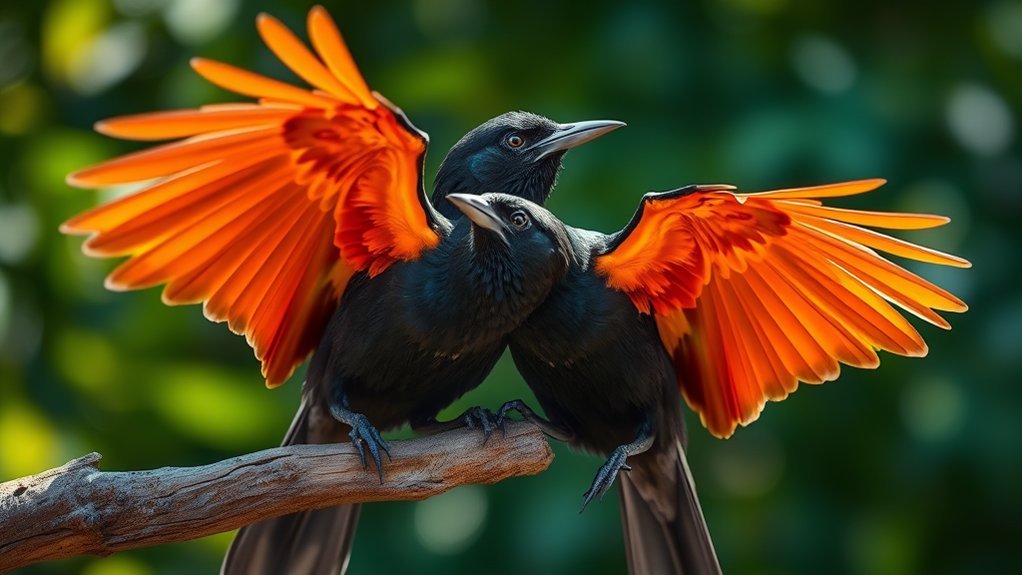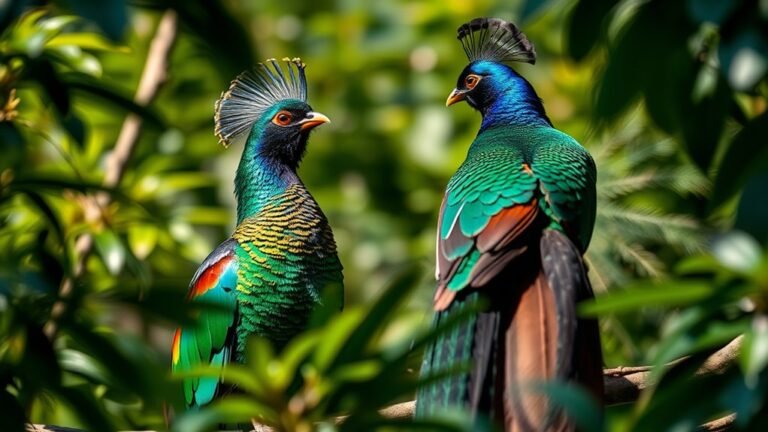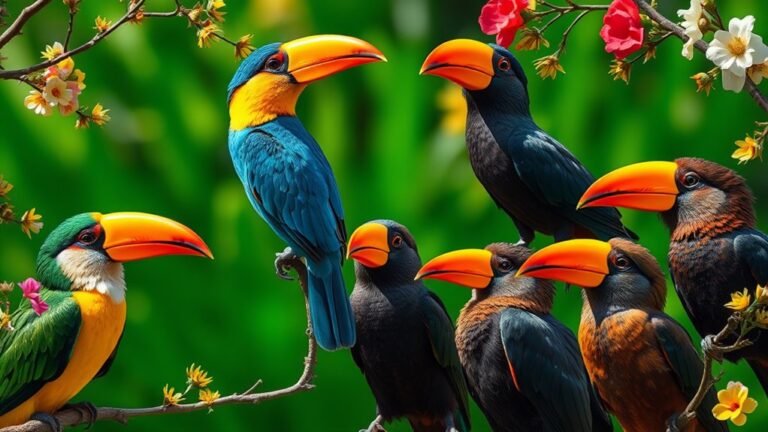Black Birds With Orange Wings: Identification and Facts
Black birds with orange wings are interesting birds found in various places. Two well-known species are the Baltimore Oriole and the Red-winged Blackbird. Each has distinctive colors and behaviors that make them easy to identify.
These birds play important roles in their environments. They help with pest control and seed dispersion, supporting plant growth. Their breeding habits vary; for example, Orioles build hanging nests, while Red-winged Blackbirds create nests on the ground or in marshes.
Conservation is vital for these species, as they face threats like habitat loss and climate change. Recognizing their importance can guide efforts to protect their habitats. What do you think are the main challenges they encounter?
Key Takeaways
- The Baltimore Oriole has bright orange and black feathers. It sings distinctive songs and often feeds in trees.
- Red-winged Blackbirds have noticeable red shoulder patches. They prefer habitats near wetlands.
- Male Orchard Orioles have vibrant orange-yellow bodies and black wings. Female Orchard Orioles are more muted in color for camouflage.
- These birds build their nests in thick plants close to water. This location helps protect their young from predators.
- Their diet includes insects, seeds, and fruits. They change their feeding habits with the seasons, which affects their role in the ecosystem.
Overview of Black Birds With Orange Wings

Black birds with orange wings are striking avian species characterized by their unique color patterns and distinct behaviors.
As you explore these intriguing birds, keep in mind essential birdwatching tips to enhance your experience. Look for them in areas rich in diverse foliage, as they thrive in specific habitats that provide food and shelter.
By practicing habitat conservation, you help maintain the ecosystems these birds depend on. Engage in local conservation efforts and advocate for sustainable practices to protect their environments.
Understanding their roles within the ecosystem fosters a sense of belonging in the birdwatching community.
You'll not only enjoy observing these remarkable birds but also contribute to their survival, creating a deeper connection with nature.
Common Species and Their Identification
While exploring the fascinating world of avifauna, you'll encounter several notable species of birds that sport distinctive black plumage and vibrant orange wings. A prime example is the Baltimore Oriole, recognized for its striking color contrast.
To identify these birds, observe their behavior; they often feed in trees and are known for their melodious songs. Look for wing color variations—some orioles may exhibit more muted tones based on age or breeding conditions.
Other species, like the Red-winged Blackbird, display bright red shoulder patches instead of orange, yet share similar habitats and behaviors.
Familiarizing yourself with these characteristics will enhance your birdwatching experience and deepen your connection to these remarkable creatures.
The Baltimore Oriole: A Closer Look

One of the most engaging species in North America, the Baltimore Oriole stands out not just for its striking orange and black plumage but also for its complex behaviors and preferences.
You'll typically find these birds in open woodlands, orchards, and suburban areas rich in tall trees and fruit-bearing plants, reflecting their habitat preferences.
Baltimore Orioles are known for their melodic vocalizations behaviors, which you might hear during the breeding season as a means of communication and territory establishment.
They're particularly adept at mimicking other bird calls, enhancing their unique audio presence in your outdoor spaces.
Engaging with these beautiful birds can deepen your appreciation for nature, highlighting the vibrant connections within your local ecosystem.
The Orchard Oriole: Distinctive Features
The Orchard Oriole, closely related to the Baltimore Oriole, showcases distinct features that set it apart.
You'll notice males have a striking appearance with a rich, orange-yellow body and black wings. Females present a more muted palette, sporting yellowish-brown feathers with less contrast. These color variations help the Orchard Oriole blend seamlessly into its surroundings, making it hard for predators to spot.
Additionally, their distinctive, musical calls and sharp, narrow bills aid in identifying them during spring migrations. With a slender build and a length of about 6 to 7 inches, these birds also exhibit a unique, pointed tail.
Observing these details enhances your appreciation for the Orchard Oriole and its role in local ecosystems.
The Red-winged Blackbird: Habitat and Behavior

Although often found in wetlands, the Red-winged Blackbird also adapts to a variety of habitats, including marshes, meadows, and even suburban areas. These birds exhibit remarkable behavioral adaptations that allow them to thrive in diverse environments.
They typically forage for insects, seeds, and grains, demonstrating flexibility in their diet. When it comes to nesting preferences, the males establish territories in dense vegetation, where they construct nests close to water sources, providing safety from predators.
Their vocalizations are integral in defending these territories and attracting mates. Additionally, you might notice their communal roosting behavior in winter, highlighting their social nature.
The Yellow-headed Blackbird: Unique Characteristics
Often mistaken for other blackbirds due to its similar shape, the Yellow-headed Blackbird stands out with its striking yellow head and chest, which creates a vivid contrast against its dark body.
You'll find these birds in wetland habitats, such as marshes and cattail stands, where they thrive. Their yellow-headed behavior includes forming large colonies and engaging in loud, distinctive calls, especially during the breeding season.
They typically nest in marsh vegetation, showcasing a preference for areas that provide ample food and cover.
As you observe them, note their unique social dynamics and the way they interact with other species. Understanding these characteristics not only enriches your experience but helps you become a part of the birdwatching community.
The Brewer's Blackbird: Identification Tips
When identifying the Brewer's Blackbird, look for its glossy black plumage and distinctive yellow eye, which set it apart from other blackbird species.
Male Brewer's Blackbirds feature a striking iridescent sheen, while females showcase more subdued browns, demonstrating the brewers' plumage variations.
During your birdwatching outings, focus on their social behavior; you often spot them in flocks, especially during Brewer's Blackbird sightings.
Note their sturdy body and long, pointed tails, critical for distinguishing them from similar species.
Pay attention to their calls, a unique mixture of whistles and raspy notes, enhancing your identification skills.
The Rusty Blackbird: Recognizing Differences
The Rusty Blackbird is distinguished by its unique coloration and behavior, setting it apart from other blackbirds.
When using identification techniques, you'll notice its dark, faintly shimmering plumage punctuated by rusty brown on the wings and flanks, especially in winter.
Observing the bird's behavior is equally important—unlike most blackbirds, the Rusty Blackbird often forages in small groups near water, showing a preference for wetland habitats.
Take note of its distinct call, which differs from the harsher voices of related species.
Geographic Distribution of Black Birds With Orange Wings
While black birds with orange wings are primarily associated with specific regions, their distribution varies considerably across North America. You'll find these birds mainly in areas with moist habitats, yet significant geographic diversity exists.
For instance, populations of the Rusty Blackbird are concentrated in the northern U.S. and Canada during breeding seasons, whereas other species may reside further south year-round.
Regional variations impact their movement patterns, as some birds migrate in response to food availability and climate conditions.
So, whether observing these striking birds in wetlands or urban parks, recognizing their diverse geographical presence allows you to appreciate their adaptability and resilience.
Understanding this distribution enhances your connection to these fascinating avian species and their role in varying ecosystems.
Preferred Habitats and Nesting Patterns
Although black birds with orange wings can thrive in various environments, they mainly prefer wetland areas, such as marshes, ponds, and riverbanks, where food sources like insects and seeds are plentiful.
Their nesting preferences reflect their habitat diversity, as they often seek dense vegetation for protection. You'll find them constructing nests in shrubs or reeds, carefully hidden from predators to guarantee safety.
Here are some key habitat features they favor:
- Proximity to water sources: Essential for feeding and drinking.
- Dense vegetation: Provides shelter and nesting opportunities.
- Seasonal wetlands: Rich in biodiversity, attracting various insect species.
Diet and Feeding Habits of These Birds
Black birds with orange wings primarily consume a varied diet consisting of insects, seeds, and fruits.
Their dietary preferences reflect a keen adaptation to their environments, allowing them to thrive in diverse habitats.
You'll observe their foraging strategies often involve active search techniques, like moving through foliage or hovering near fruits, which help them access food efficiently.
Additionally, these birds may exploit seasonal changes, shifting their diet based on the availability of resources.
Understanding these feeding habits highlights their role in the ecosystem, particularly in seed dispersal and pest control.
Breeding and Reproductive Behavior
The breeding behavior of black birds with orange wings reveals complex strategies that enhance their reproductive success. During the mating season, males engage in elaborate courtship displays, showcasing their vibrant plumage to attract females. These displays not only highlight their fitness but also establish territory.
Once paired, they initiate nesting rituals that are essential for raising their offspring.
- Males sing and perform aerial displays to impress females.
- Both parents collaborate in selecting a nesting site and constructing the nest.
- They exhibit parental care by feeding and protecting the young.
Migration Patterns and Seasonal Changes
As seasonal changes occur, black birds with orange wings commence on remarkable migration journeys that reflect their adaptability.
These migrations are primarily triggered by variations in temperature and food availability, prompting them to seek more favorable climates.
You'll notice that their departure often coincides with the onset of colder months, demonstrating their biological instinct for survival.
During migration, these birds exhibit impressive seasonal adaptations, such as altering their flight patterns and forming large flocks to enhance safety and navigation.
They rely on various environmental cues, including daylight duration and geographic landmarks, to guide their paths.
Understanding these migration patterns not only highlights their resilience but also fosters a deeper appreciation for these remarkable avian travelers and their connection to changing ecosystems.
The Role of Black Birds in Ecosystems
While many may overlook them, black birds with orange wings play an important role in their ecosystems. These birds help maintain ecosystem balance through their interactions with both plants and other wildlife. As foragers, they contribute to seed dispersal, which promotes vegetation growth.
Additionally, they serve as prey for various predators, ensuring that energy flows through the food chain.
Key roles include:
- Regulating insect populations by feeding on them, reducing crop damage.
- Acting as indicators of environmental health, reflecting ecosystem changes.
- Participating in social structures that influence species diversity.
Understanding these roles is significant, as they highlight the interconnectedness of life and the importance of preserving biodiversity in maintaining ecosystem integrity.
Conservation Status and Threats to Their Populations
Maintaining the balance of ecosystems becomes increasingly challenging as black birds with orange wings face numerous threats to their populations. Habitat loss due to urbanization and agricultural expansion is a significant factor, forcing these birds to compete aggressively for dwindling resources.
Additionally, climate change alters their migration patterns and food availability, exacerbating population threats. Conservation efforts are essential to mitigate these issues, including habitat restoration and the establishment of protected areas.
Engaging local communities in monitoring and awareness programs can promote understanding and support for these birds. It's important to foster a sense of urgency within society to protect these striking birds, ensuring they continue to thrive in their natural habitats for future generations.
Frequently Asked Questions
Do Black Birds With Orange Wings Migrate Alone or in Groups?
Black birds with orange wings usually migrate in groups. These flocks help them stay safe and find their way. Observing their migration can enhance your understanding of their behavior and improve your birdwatching experience.
What Time of Year Do These Birds Typically Breed?
These birds usually start breeding in early spring. They find safe places to build their nests. As the weather gets warmer, they attract mates with bright colors.
How Long Do Black Birds With Orange Wings Live?
Black birds with orange wings usually live between 2 and 15 years. Their lifespan depends on factors like diet, predators, and their habitat. To help them live longer, it is important to protect their natural environments and reduce threats. Keeping their habitats safe can enhance their chances of a healthy life.
Are There Any Myths or Folklore Surrounding These Birds?
Many cultures tell stories about these birds. They often symbolize change or good luck. These narratives reflect their important roles in nature and how people have understood them throughout history.
Do Any Predators Specifically Target Black Birds With Orange Wings?
Some predators, like hawks and snakes, target birds with bright colors. They use various hunting methods, such as hiding or watching from high places. These tactics help them spot and catch birds with orange wings more easily.

Kashvi is a passionate bird enthusiast and nature lover who has been fascinated by the world of birds for years. With a keen eye for detail and a love for learning, Kashvi is dedicated to sharing her knowledge and insights with fellow bird enthusiasts on Avian Enthusiasts. Through her engaging and informative articles, Kashvi aims to inspire others to join her in exploring the fascinating world of birds and to promote a deeper appreciation for these incredible creatures.







